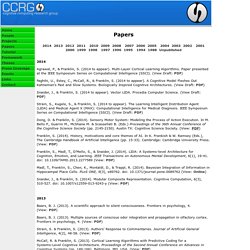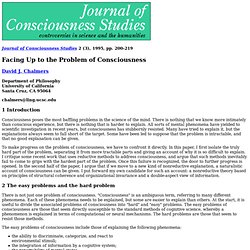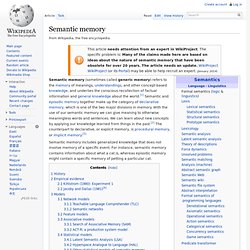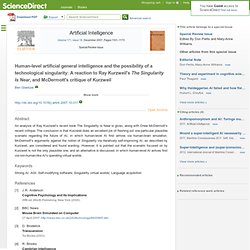

CCRG - Cognitive Computing Research Group - Papers. 2014 2013 2012 2011 2010 2009 2008 2007 2006 2005 2004 2003 2002 2001 2000 1999 1998 1997 1996 1995 1994 1988 Unpublished Agrawal, P., & Franklin, S. (2014 to appear).

Multi-Layer Cortical Learning Algorithms. Paper presented at the IEEE Symposium Series on Computational Intelligence (SSCI). (View Draft: PDF) Faghihi, U., Estey, C., McCall, R., & Franklin, S. (2014 to appear).
인공지능 비판의 철학 : 이초식. Deep learnning. IPAM - Schedule. KemView.do 1,024×768픽셀. WandoraWiki. This page collects Wandora's documentation.

The documentation is a work in progress and incomplete. Also note some documentation may be out of date as the application is developed actively. If you need any specific help, write your question to the discussion forum. Wandora's YouTube channel has several tutorial videos reviewing some application features. Would you like to edit this wiki, send an email to support wandora.org with your name and information about how you'd like to contribute. Introduction Wandora is a general purpose information management application. Starting with Wandora Wandora is a desktop application written in Java version 8. Topic Maps Wandora's internal datamodel is based on Topic Maps. See also Topic map layers section below.
Using Wandora This section contains basic tutorials for Wandora. Facing Up to the Problem of Consciousness. Journal of Consciousness Studies 2 (3), 1995, pp. 200-219 David J.

Chalmers Department of Philosophy University of California Santa Cruz, CA 95064 chalmers@ling.ucsc.edu 1 Introduction Consciousness poses the most baffling problems in the science of the mind. To make progress on the problem of consciousness, we have to confront it directly. 2 The easy problems and the hard problem There is not just one problem of consciousness. The easy problems of consciousness include those of explaining the following phenomena: the ability to discriminate, categorize, and react to environmental stimuli; the integration of information by a cognitive system; the reportability of mental states; the ability of a system to access its own internal states; the focus of attention; the deliberate control of behavior; the difference between wakefulness and sleep.
나 름. NARS. 10대의 뇌에 관한 자료. ANDROID : 인간 친화적 상호작용을 위한 안드로이드 로봇의 감성 시스템. Reinforcement Learning and Artificial Intelligence, worldwide. Semantic memory. Semantic memory (sometimes called generic memory) refers to the memory of meanings, understandings, and other concept-based knowledge, and underlies the conscious recollection of factual information and general knowledge about the world.[1] Semantic and episodic memory together make up the category of declarative memory, which is one of the two major divisions in memory.

With the use of our semantic memory we can give meaning to otherwise meaningless words and sentences. We can learn about new concepts by applying our knowledge learned from things in the past.[2] The counterpart to declarative, or explicit memory, is procedural memory, or implicit memory.[3] Semantic memory includes generalized knowledge that does not involve memory of a specific event. For instance, semantic memory contains information about what a cat is, whereas episodic memory might contain a specific memory of petting a particular cat. AtomSpace. The OpenCog AtomSpace is a knowledge representation (KR) database and the associated query/reasoning engine to fetch and manipulate that data, and perform reasoning on it.

RelEx Dependency Relationship Extractor. RelEx, a narrow-AI component of OpenCog, is an English-language semantic dependency relationship extractor, built on the Carnegie-Mellon Link Grammar parser.

It uses a series of graph rewriting rules to identify subject, object, indirect object and many other syntactic dependency relationships between words in a sentence. Development Platforms. Artificial General Intelligence - Google 그룹스. Lukasz Stafiniak pages. Overall course focus: (hmm…) Reinforcement learning.

Concept formation and program synthesis. Adaptive and probabilistic logics. Mental development theory. Notes: Pioneers in Artificial Intelligence. SOAR 소개. Soar. Soar News and Announcements We are pleased to announce the 34th Soar Workshop!

It will be held the week of June 16th, 2014 at the University of Michigan in Ann Arbor. There is no charge to attend the workshop, although registration is required. For more detailed information, please visit the the workshop home page linked above, which will have the most up-to-date information.New Soar publication: Kirk, J. and Laird J. Artificial Intelligence - Human-level artificial general intelligence and the possibility of a technological singularity: A reaction to Ray Kurzweil's The Singularity Is Near, and McDermott's critique of Kurzweil. Volume 171, Issue 18, December 2007, Pages 1161–1173 Special Review Issue Edited By Don Perlis and Mary-Anne Williams Open Archive Abstract.

Artificial Intelligence - From here to human-level AI. Volume 171, Issue 18, December 2007, Pages 1174–1182 Special Review Issue Edited By Don Perlis and Mary-Anne Williams Open Archive Abstract Human-level AI will be achieved, but new ideas are almost certainly needed, so a date cannot be reliably predicted—maybe five years, maybe five hundred years.

AGI Introduction - narswang. [The video of a lecture based on this note is on-line.] 1. Adaptive Artificial Intelligence Inc.-Research Real A.I. Intro. Introduction This is a book chapter written by Peter Voss and published in "Artificial General Intelligence" - Goertzel, Ben; Pennachin, Cassio (Eds). Written in 2002, this describes the foundation of our project: the low level, conceptual underpinnings that remain an important functioning part of our current more advanced research.
Note that many crucial aspects of our current working model of higher-level intelligence are not explicitly detailed in the book chapter that follows below, or were developed after the chapter was written. Equal numbers of neuronal and nonneuronal cells make the human brain an isometrically scaled-up primate brain - Azevedo - 2009 - Journal of Comparative Neurology. Strong AI. Singularity: Artificial Intelligence Will Kill Our Grandchildren.
DRAFT 9 Dr Anthony Berglas January 2012 Anthony@Berglas.org (Copy at will but provide attribution) Abstract There have been many exaggerated claims as to the power of Artificial Intelligence (AI), but there has also been real progress. Computers can drive cars across rough desert tracks, understand speech, and prove complex mathematical theorems. It is difficult to predict future progress, but if a computer ever became about as good at programming computers as people are, then it could program a copy of itself. This would lead to an exponential rise in intelligence (now often referred to as the Singularity). This paper reviews technical progress in Artificial Intelligence and some philosophical issues and objections. Contents Introduction Modern motor cars may be an order of magnitude more complex than cars of the 1950s, but they perform essentially the same function.
Likewise, computers appear to have plateaued in the 1980s, when all our common applications were built. DREAM-LOGIC, THE INTERNET AND ARTIFICIAL THOUGHTBy David Gelernter. What does it mean to think? Can machines think, or only humans? These questions have obsessed computer science since the 1950s, and grow more important every day as the internet canopy closes over our heads, leaving us in the pregnant half-light of the cybersphere.